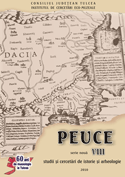La ricerca sui Goti nell’ Italia nordorientale e nelle regioni contermini
The Research on the Goths in North-Eastern Italy and in the Bordering Area
Author(s): Maurizio BuoraSubject(s): Archaeology
Published by: Institutul de Cercetari Eco-Muzeale Tulcea - Institutul de Istorie si Arheologie
Keywords: Goths; North-Eastern Italy; Aquileia; Monte Barro;
Summary/Abstract: In the opinion of Aristide Calderini, Italian scholar of the twentieth century, during the period from Attila to the Byzantines, Aquileia lost “primacy and prosperity”. The idea, extended to the whole of Italy, is shared by many Italian historians until well into the Second World War, when the studies of some German scholars became common knowledge, especially there carried out by Volker Bierbrauer, and after major exhibitions, based on archaeological investigations, have revealed a very different situation. Although in Italy the Goths could not enjoy of a political background, contrary to the Lombards that are recently seen by political trends as anti-Roman, they have become better known over time. The interest for this period and the Goths in particular has been greatly enhanced by the Anglo-Saxon scholars, always attentive to the phenomena of melting pot. In recent decades, new excavations were carried out in archaeological sites inhabited by the Goths: the site of Monte Barro near Lecco, Lombardy – lived about 480 to 540 – is particularly important and offers a standard of comparison for many classes of material. New necropolis (Dravlje in Slovenia, Globasnitz in Austria) provide some evidence to recognize the customs of the Goths and their mixing with the local population. It is now thought that the city of Aquileia remained inhabited within the ancient walls until at least the fifth century, before being cut in half by the mid-sixth century Byzantine zigzag new walls. We also know many aspects of its continuity in the 5th, 6th and 7 th centuries. At the time of the Goths, although not always to this population, generally are attributed certain elements of ornament; they nevertheless, according to a well-known definition of M. Kazanski, may belong to the so-called “mode danubienne”. They were often found in small towns and rural villas. Much attention recently has had other phenomena. The first is the coinage and the coins circulation of the Goths, on which, nevertheless there are strong suspicions of counterfeit, with regard to some old discoveries. The second is the artificial deformation of skulls, which became evident through the systematic excavations of the necropolis in most areas of Europe: in Italy it is now documented in Collegno, Chiusi and perhaps at Padua. However, many problems remain open. One of the most evident is the chronology of some fibulae: that in Italy tends currently to diverge from the Crimea, one based on excavations of Aibabin and developed by Kazanski and others.
Journal: Peuce (Serie Nouă) - Studii şi cercetari de istorie şi arheologie
- Issue Year: VIII/2010
- Issue No: 8
- Page Range: 185-202
- Page Count: 18
- Language: Italian

